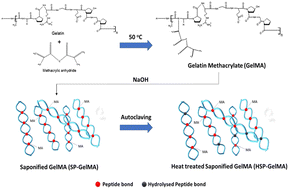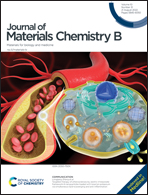Improving printability of hydrogel-based bio-inks for thermal inkjet bioprinting applications via saponification and heat treatment processes†
Abstract
Material jetting bioprinting is a highly promising three-dimensional (3D) bioprinting technique that facilitates drop-on-demand (DOD) deposition of biomaterials and cells at pre-defined positions with high precision and resolution. A major challenge that hinders the prevalent use of the material jetting bioprinting technique is due to its limited range of printable hydrogel-based bio-inks. As a proof-of-concept, further modifications were made to gelatin methacrylate (GelMA), a gold-standard bio-ink, to improve its printability in a thermal inkjet bioprinter (HP Inc. D300e Digital Dispenser). A two-step modification process comprising saponification and heat treatment was performed; the GelMA bio-ink was first modified via a saponification process under highly alkali conditions to obtain saponified GelMA (SP-GelMA), followed by heat treatment via an autoclaving process to obtain heat-treated SP-GelMA (HSP-GelMA). The bio-ink modification process was optimized by evaluating the material properties of the GelMA bio-inks via rheological characterization, the bio-ink crosslinking test, nuclear magnetic resonance (NMR) spectroscopy and the material swelling ratio after different numbers of heat treatment cycles (0, 1, 2 and 3 cycles). Lastly, size-exclusion chromatography with multi-angle light scattering (SEC-MALS) was performed to determine the effect of heat treatment on the molecular weight of the bio-inks. In this work, the 4% H2SP-GelMA bio-inks (after 2 heat treatment cycles) demonstrated good printability and biocompatibility (in terms of cell viability and proliferation profile). Furthermore, thermal inkjet bioprinting of the modified hydrogel-based bio-ink (a two-step modification process comprising saponification and heat treatment) via direct/indirect cell patterning is a facile approach for potential fundamental cell–cell and cell–material interaction studies.

- This article is part of the themed collection: 2023 Journal of Materials Chemistry B Lunar New Year


 Please wait while we load your content...
Please wait while we load your content...